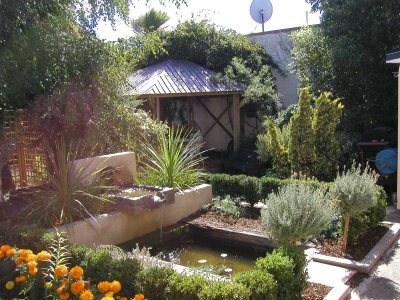Evolution Of A Garden

No garden is ever completely finished; it is always at a certain stage of development. Its cultivation involves us in endless creative activity. We are constantly influencing its evolution towards what we want of the garden as a whole. So any plans for creating or altering a garden must take into account the aspects of space and time.
The first thing that is subject to change is the garden's economic yield. For instance, after planting apple trees we have to wait for several years before they bear much fruit. This time gap can be billed in by the cultivation of soft fruit, such as currants, gooseberries, raspberries and blackberries and strawberries.

The decorative garden also changes from year to year. In the early stages, when especially the newly planted trees and shrubs are small, it is not very effective aesthetically. It sometimes takes many years for a garden to attain its full aesthetic effect. But this wait for the desired result can be compensated for by strategic short-term planting to create a 'temporary beauty'. These plants, too, will later be discarded or restricted according to the progress of those planted for more long-term effectiveness.
These decorative short-term plantings may be of many kinds. In the first instance, use can be made of quick-grwoing shrubs, which provide a tall, thick screen in a relatively short time. However, care must be taken that they do not compete too strongly with other plants. It often happens that these 'temporary' plants push our or weaken those intended to be permanent, so that the original aim is never fulfilled, or at best becomes still more distant. To avoid such possiblilities, plant temporary, quick-growin gwoody plants at some distance from those that you intend should remain permanently.

Another way is to plant long-term shrubs more closely together than usual, so that their foliage grows together more quickly and the desired overall effect is achieved sooner -- a compact and pleasant mass of green. This kind of thick planting is suitable from the biological and technological point of view too. The thick growth of the shrubs makes for a more favourable microclimate, important for instance in dry sites. There is also less danger of infestation by weeds, and this favourable effect, in turn, improves the growth of the plants.

Bushes make a good thick growth, but trees can also be used. These thick growths may be either permanent or temporary, but care must be taken if the two are mixed, because when endeavouring to thin out the temporary ones later there is considerable risk of damaging the permanent stock.

To guarantee the aesthetic effect of temporary groups of plants they must be chosen to group well together. For instance a young group of low, spreading junipers may be thickened with medium-high perennial grasses, the low-growing garden roses look well in a group of pine trees and so on.







0 Comments:
Post a Comment
<< Home